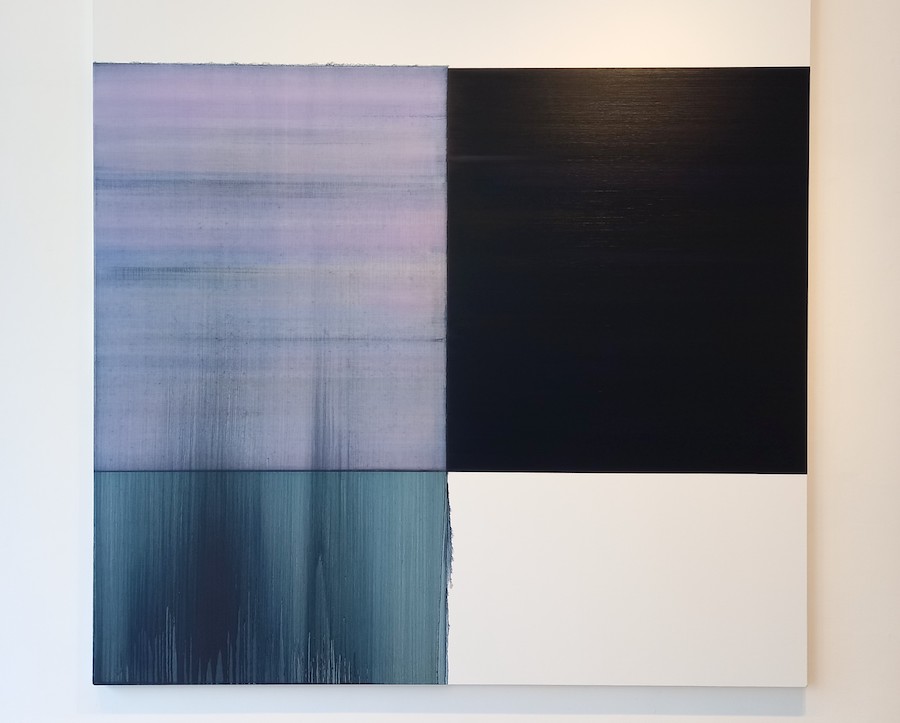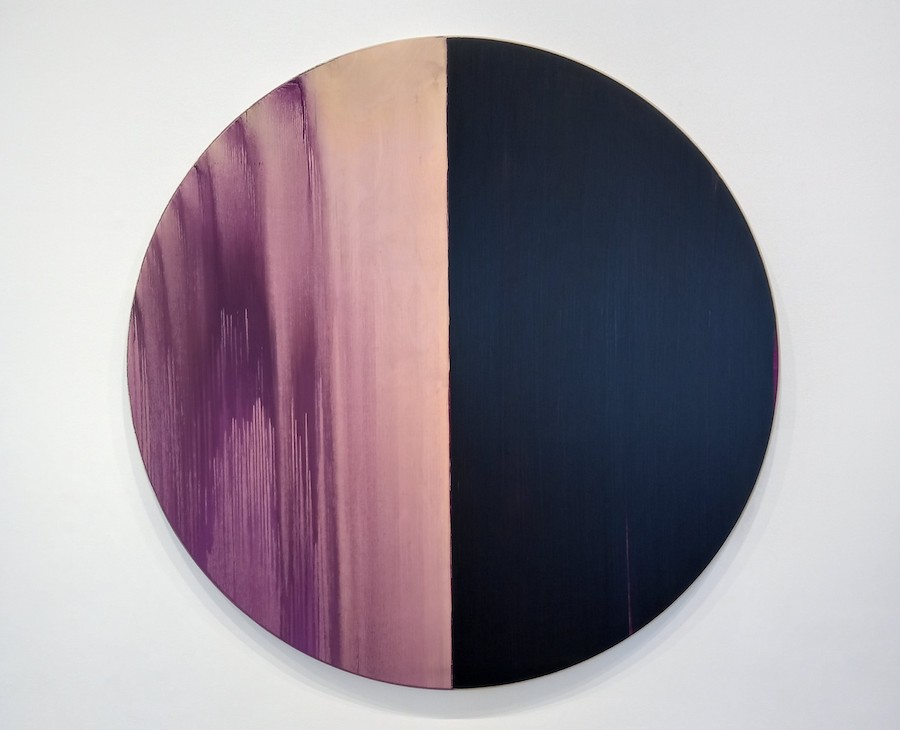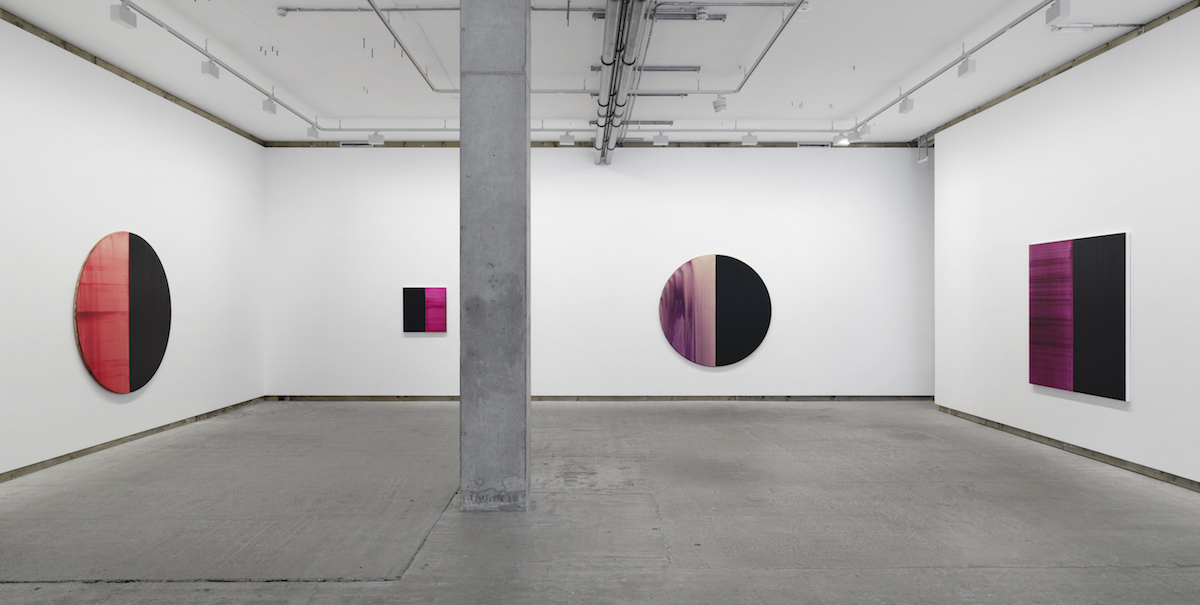Over the past four decades, Callum Innes has worked in series, creating luminous abstractions which expose the fundamentals of painting: pigment, surface and space. His tenth show at Frith Street Gallery is the first to include new circular paintings alongside rectangular canvases. The two streams of work are made in the two studios between which Innes divides his time: Tondos on birch ply in his home city of Edinburgh, rectangular canvases in Oslo.
You’re known for the play between addition and removal in your work, in particular for using turpentine to ‘unpaint’ the canvas, leaving only vestigial traces of colour. How does that operate in, for example, ‘Exposed Painting Delft Blue / Violet Red Oxide’, 2019?
I’m reducing and adding repeatedly. What people don’t see is that there been a blue put down first, then a violet, then a red, then a green, then a blue again, and a black over it all, and it’s been gone into several times. The history of all that is there. For example, the black line you see running across horizontally halfway up on one side actually runs all the way across. This is the biggest size I’ve ever worked on – I can still just about go across in one stroke on a platform. If I couldn’t do that, it would be too big. And this work achieves a ‘watercolour effect’, which I’d always found difficult on canvas before. This is also the oldest painting in the show, and one I didn’t see for two years as it was in Edinburgh while I was in Oslo when Covid shut the borders.

‘Exposed Painting Delft Blue / Violet Red Oxide’, 2019 – oil on canvas, 250 x 242 cm Photo: Paul Carey-Kent
You have consistently used black?
Yes, but in the early exposed paintings I would mix all the colours into the black and then reveal the colour. With these recent works I’ve been into the painting maybe five or six times, putting different colours on, exposing that side, drying off, evaporating. There’s much more addition than there used to be.
And the white of the canvas is equally important?
It is. When I have studio guests who are seeing my work for the first time, and they ask ‘how do you paint the white bit at the bottom there?’, then I know it’s working, that there’s spatial ambiguity. I like when the painting spirals from something very simple to something very complex. You don’t know what’s behind what, where’s the foreground. I like that idea of ‘where is space in the painting?’, and how you physically react to it.

‘Untitled Lamp Black / Deep Purple Dioxazine’, 2023 – Oil on Birch Ply, 180 cm. Photo: Paul Carey-Kent
What led you to the circular format?
The round form originally emerged when painting the end of a whiskey barrel for charity. I really enjoyed working on the hard surface of oak, later birch, and the fact it was wood, so I could see the grain and leave it coming through. After that I thought it would be quite nice to extend it, and to push the work forward through the Tondo.
Why do you make the Tondos in Edinburgh?
Because they’re quite heavy – about 70 kilos each, they’re backed with aluminium to prevent warping – and I have assistants there. I’ve been working on them for about two years, on and off, as I travel back and forward to and from Oslo. There I have a smaller studio and no one really to help me lift things around – so I carry on with the rectangular format on canvas. For me it works really well having two studios. I’ve discovered that it’s very helpful to make something in Edinburgh, not see it for three or four weeks, then come back and see it afresh. My paintings are all about landscape and light, and the studios have very different light: Edinburgh has a very beautiful north top light, Oslo has a hard sidelight – sometimes I have to cover the window to kill the light.
What difference is made by the change of surface?
It changes the physicality of my painting. It’s tough on wood. I knackered my wrist the first few weeks. And it has a very different grip. Canvas sits very comfortably, the birch ply has more physical presence. And they’re heavier metaphorically, as well as physically. I keep the bevel facing out, which expands the painting, so – depending on where you stand – one side can look larger than the other. I found it surprising, the first time I showed one, how physical they are.

‘Exposed Painting Imperial Blue’, 2023 – Oil on Birch Ply, 180 cm. Courtesy the artist and Frith Street Gallery, London.
Do you hope to generate a spiritual dimension?
That’s for someone else to say. They are about light and landscape, how you look up and see that sky. The research for my practice is actually being outside and walking down the coast or through the countryside. But I won’t title them like that because that shuts it down a wee bit. They’re moments in time.
Do you draw on your walks?
If I’m out I’ll sit down and sketch the landscape, but I haven’t shown them. It something that’s always there. I think by sketching I am absorbing. I’m happiest walking – that’s my pleasure – and the colours are all there in the landscape. Also, every day in Oslo I take these beautiful fold-out books and try to make ten or more abstract drawings before I start, like a musician playing scales, and that’s really helped me. I have over 300 books now, but I’m not sure what I’ll do with them.
Do you have a skill you enjoy other than painting?
I’m an OK cook. I enjoy it, and it’s the same process as mixing paints: a bit of this, a bit of that, you don’t know what you’ll end up with.
Top Photo: Installation view, Callum Innes, Frith Street Gallery,Golden Square. Photo: Ben Westoby, Courtesy the artist and Frith Street Gallery, London
Callum Innes is at Frith Street Gallery, 17-18 Golden Square, London to 1 July. You can also see him on the gallery website, talking in his Edinburgh studio.

